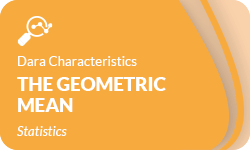
The geometric mean is a critical mathematical concept, mainly used in fields like statistics and geometry, offering an alternative perspective on averages compared to the more commonly known arithmetic mean. Measurements of central tendency can, in general, give you quick but valuable information about a dataset. The following article will set its focus on the geometric mean, explaining everything you need to know about this topic with various examples.
Definition: Geometric mean
The geometric mean multiplies all values together and then takes the nth root. This approach is particularly useful when dealing with quantities that increase or decrease exponentially, such as growth rates and ratios.
Calculation
The geometric mean is found by performing two basic operations:
- Multiply all values of the set.
- Extract the nth root of the sum (n is the total number of values).
It is important to keep in mind the following before trying to calculate this central tendency indicator:
- The GM only works with positive numbers.
- The GM will be 0 if any value in the data set is zero.
The outlier effect
Outliers are numbers in a data set that are vastly larger or smaller than the other values in the set. However, as the following example shows, it has no significant effect on the geometric mean.
Usage
The geometric mean is best used with percentages and fractions, also called ratio data, as it provides more accurate data. The arithmetic mean, on the other hand, is preferably used with discrete variables and whole values.
Furthermore, the geometric mean is also more precise with widely ranging data and dependent values. This refers to data, which is connected either in a way that changing one value results in a change of the others too (like percentages) or where the next value depends on the previous one (growth rates).
Usually, ratio data is mainly positive and thus usable for the geometric mean. However, there may be cases where you are confronted with negative percentages, for example with negative growth rates. These have to be framed positively by subtracting their value from 100%.
When to use which mean?
If you are unsure which mean to use in your case, you should first of all determine which type of data you have. A dataset containing only discrete data of independent and integral values will always be preferably used for the arithmetic mean. If the data is dependent, wide ranged, or fractioned, you should use the geometric mean.
Printing Your Thesis With BachelorPrint
- High-quality bindings with customizable embossing
- 3D live preview to check your work before ordering
- Free express delivery
Configure your binding now!
Measures of central tendency
Not each measure of central tendency can be used with every type of variable, and some might be unnecessary even though you can calculate them.
Variables are, first of all, divided into qualitative variables (which do not hold numerical value) and quantitative variables (which have numerical value). Qualitative variables are furthermore split into nominal variables, which include options that cannot be sorted hierarchical, while ordinal variables, can be ranked. Quantitative variables split into discrete variables, where you can count the individual values, and continuous variables, where you usually measure the values.
The following table will summarize when you can use which measure of central tendency. Below I will explain only the column of the geometric mean. For information on the other ones, please see the corresponding articles linked in the table.
Mode
Median
Arithmetic mean
Geometric mean
Nominal v.
x
Ordinal v.
x
Only odd-numbered
Only if numbered
Discrete v.
x
x
x
x
Continuous v.
Only in intervals
x
x
x
The geometric mean can only be applied with quantitative data, meaning discrete and continuous variables, as these are the only types where mathematical operations can be performed.
In theory, calculating the geometric mean with numbered ordinal data would be possible. However, it is never used in such cases since the arithmetic mean would be the preferred measure of mean.
FAQs
The geometric mean is a measure of central tendency, calculating the nth root of the multiplication of all values. It calculates an oftentimes more precise average than the arithmetic mean, especially when it comes to ratio data like fractions or percentages.
The GM is used when calculating an average of fractions, percentages, and dependent data. It multiplies all values before extracting the nth root.
The arithmetic mean, commonly known as “the mean,” is the most used measure of central tendency. It is used for independent, integral data, dividing the sum of values by their number. The geometric mean uses multiplication and extracting the nth root to average percentages or dependent data.
No, it’s impossible to compute the geometric mean for a set that contains negative values. This is because extracting the root of a negative value results in an error.